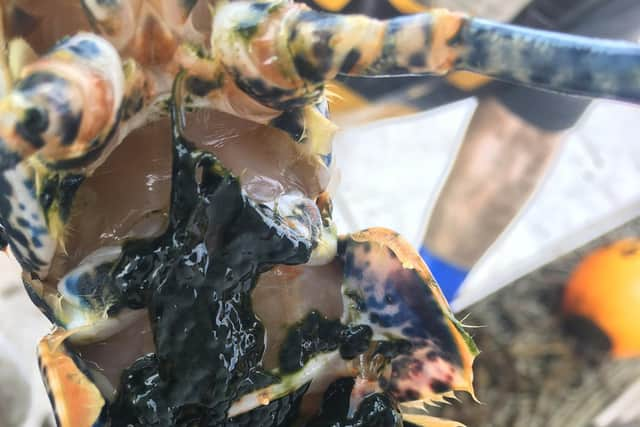Biologist’s concern as lobster eggs ‘turn to slime’ off Yorkshire coast
Joe Redfern, manager of Whitby Lobster Hatchery, said stress may have caused the lobsters to release eggs prematurely but “but nobody seems to really have a definite answer”.
“It’s not something I’ve seen before. It’s not like anything any of the fishermen have seen before, which is concerning,” he said.
Advertisement
Hide AdAdvertisement
Hide Ad“A lot of people have been fishing there for years and years and have never seen a lobster in that sort of state.”


Samples have been sent to the Centre for Environment, Fisheries and Aquaculture for analysis, after the eggs were found in Whitby and Hartlepool.
It comes almost a year after dead lobsters and crabs began washing ashore in Yorkshire and the North East, but Mr Redfern said he does not want to jump to conclusions and claim there is any link to the mass die off until the analysis has been completed.
Thousands of crustaceans have been found dead since October, and an investigation led by the Department for Environment, Food and Rural Affairs (Defra), found a naturally occuring algal bloom is “the most likely cause”.
Advertisement
Hide AdAdvertisement
Hide AdLocal fishermen, who claim their livelihoods are at risk because catches have been decimated, believe the deaths are linked to harmful chemicals disturbed by dredging in the River Tees, but the investigation ruled this out.
The North East Fishing Collective, led by Mr Redfern, is now planning to take legal action and challenge the findings of the Government investigation.
The Government has resisted calls to reopen the investigation and said fishermen affected by the lobster and crab deaths will not be compensated because it is a naturally occuring event.
Speaking in Parliament in July, Environment Minister Victoria Prentis defended and investigation and said it involved “extensive testing, research and analysis”.
Advertisement
Hide AdAdvertisement
Hide AdShe added: “While we concluded that the most likely cause was the harmful algal bloom, we may never know for sure what caused this event.”
But later that month, marine pollution consultant Tim Deere-Jones, who was hired by local fishermen to analyse Defra’s investigation, cast doubt over the findings.
According to Mr Deere-Jones, “very small numbers of harmful algae” were found in water samples and they were “far below the concentrations expected to occur in a developed bloom intense enough to kill so much marine life”.
He also stated the chemical pyridine is “strongly suspected” to be the cause, as it has been produced as a by-product of industrial activity around the River Tees for more than 100 years and there is evidence to suggest sediment containing the chemical may have been disturbed by dredging.
Advertisement
Hide AdAdvertisement
Hide AdPyridine was found in some of the crabs, but Defra said the chemical, which can form naturally in crustaceans after death, did not kill them and “varying amounts” have been found in crabs in other parts of the UK.
However, Mr Deere-Jones said the Government agency has failed to explain why levels of pyridine found in crabs in the North-East were around 80 times higher than those found in crabs in Cornwall.